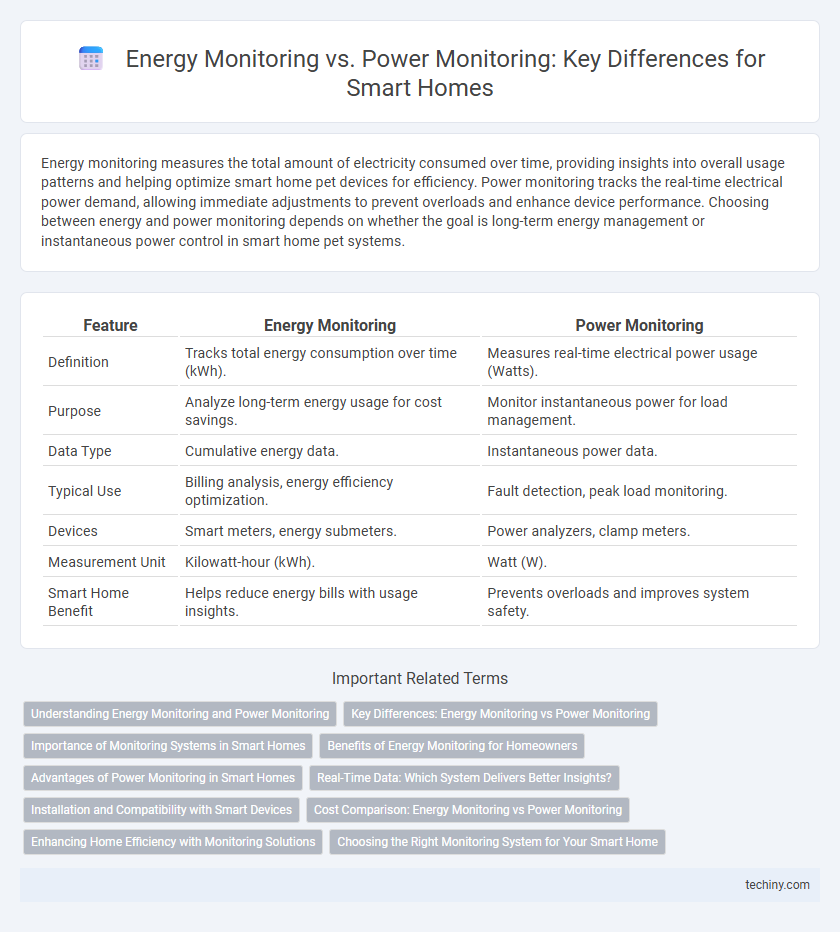Energy monitoring measures the total amount of electricity consumed over time, providing insights into overall usage patterns and helping optimize smart home pet devices for efficiency. Power monitoring tracks the real-time electrical power demand, allowing immediate adjustments to prevent overloads and enhance device performance. Choosing between energy and power monitoring depends on whether the goal is long-term energy management or instantaneous power control in smart home pet systems.
Table of Comparison
| Feature | Energy Monitoring | Power Monitoring |
|---|---|---|
| Definition | Tracks total energy consumption over time (kWh). | Measures real-time electrical power usage (Watts). |
| Purpose | Analyze long-term energy usage for cost savings. | Monitor instantaneous power for load management. |
| Data Type | Cumulative energy data. | Instantaneous power data. |
| Typical Use | Billing analysis, energy efficiency optimization. | Fault detection, peak load monitoring. |
| Devices | Smart meters, energy submeters. | Power analyzers, clamp meters. |
| Measurement Unit | Kilowatt-hour (kWh). | Watt (W). |
| Smart Home Benefit | Helps reduce energy bills with usage insights. | Prevents overloads and improves system safety. |
Understanding Energy Monitoring and Power Monitoring
Energy monitoring tracks total energy consumption over time, measured in kilowatt-hours (kWh), providing insights into usage patterns and cost efficiency for smart home devices. Power monitoring measures real-time electrical power usage, expressed in watts (W), enabling immediate detection of high-demand appliances and potential overloads. Understanding both metrics allows homeowners to optimize energy savings and enhance overall smart home performance.
Key Differences: Energy Monitoring vs Power Monitoring
Energy monitoring measures the total amount of electricity consumed over a period, typically expressed in kilowatt-hours (kWh), providing insights into long-term usage patterns and cost analysis. Power monitoring, on the other hand, tracks the instantaneous electrical power in watts (W), enabling real-time detection of energy spikes and efficient management of device performance. Understanding these key differences helps optimize smart home energy efficiency by balancing immediate power needs with overall consumption trends.
Importance of Monitoring Systems in Smart Homes
Energy monitoring systems in smart homes provide comprehensive data on total energy consumption over time, enabling homeowners to optimize usage patterns and reduce utility bills. Power monitoring focuses on real-time measurement of electrical load, helping to prevent overloads and improve safety by detecting irregular power surges. Combining both monitoring systems enhances overall energy efficiency, contributing to smarter energy management and sustainable living environments.
Benefits of Energy Monitoring for Homeowners
Energy monitoring provides homeowners with detailed insights into overall electricity consumption patterns, enabling more effective management of energy use and cost savings. Unlike power monitoring, which measures instantaneous power draw, energy monitoring tracks cumulative energy usage over time, helping identify inefficiencies and high-consumption devices. This data-driven approach supports smarter energy decisions, reduces utility bills, and promotes sustainable living in smart homes.
Advantages of Power Monitoring in Smart Homes
Power monitoring in smart homes offers precise real-time tracking of electrical consumption, enabling homeowners to identify energy-hungry devices and optimize usage efficiently. Unlike general energy monitoring, power monitoring provides granular data on voltage, current, and power factor, facilitating predictive maintenance and reducing utility costs. Enhanced control through power monitoring supports automation systems to respond instantly to power fluctuations, improving overall home energy management and safety.
Real-Time Data: Which System Delivers Better Insights?
Energy monitoring systems analyze overall consumption patterns over time, offering comprehensive data on household energy usage and efficiency. Power monitoring focuses on real-time measurement of electrical load, providing instantaneous insights into device-level power consumption and immediate anomaly detection. For detailed, actionable insights that support prompt energy-saving decisions, power monitoring with real-time data delivers superior accuracy and responsiveness compared to broader energy monitoring systems.
Installation and Compatibility with Smart Devices
Energy monitoring systems typically require meters that measure total energy consumption over time, making installation more involved and often necessitating compatibility checks with existing electrical panels and smart home hubs. Power monitoring focuses on real-time power usage, usually via plug-in smart plugs or inline monitors that are easier to install and more broadly compatible with various smart devices and ecosystems. Choosing between the two depends on the home's existing infrastructure and the desired level of integration with devices like smart thermostats, lighting, and voice assistants.
Cost Comparison: Energy Monitoring vs Power Monitoring
Energy monitoring systems track cumulative energy consumption over time, offering detailed insights into overall usage patterns that help users manage utility costs effectively. Power monitoring measures real-time power flow, enabling immediate detection of high-demand appliances and peak usage periods, which can prevent excess charges from demand spikes. Cost comparison reveals energy monitoring often incurs lower upfront expenses and maintenance fees, whereas power monitoring may require higher initial investment but provides granular data that can optimize energy efficiency and reduce long-term operational costs.
Enhancing Home Efficiency with Monitoring Solutions
Energy monitoring tracks overall consumption patterns and energy costs in a smart home, providing insights for optimizing usage and reducing utility bills. Power monitoring focuses on real-time measurement of electrical power in specific appliances or circuits, enabling immediate adjustments to prevent wastage. Integrating both solutions enhances home efficiency by delivering comprehensive data for informed decision-making and targeted energy-saving strategies.
Choosing the Right Monitoring System for Your Smart Home
Energy monitoring tracks total electricity consumption over time, providing detailed insights into usage patterns and helping optimize household efficiency. Power monitoring measures real-time electrical load, enabling immediate detection of high consumption devices and preventing overloads. Selecting the right system depends on whether you prioritize long-term energy analysis or instant power management for your smart home.
Energy Monitoring vs Power Monitoring Infographic

 techiny.com
techiny.com